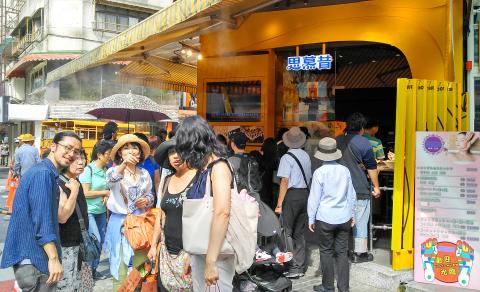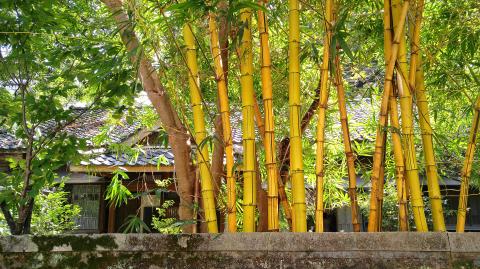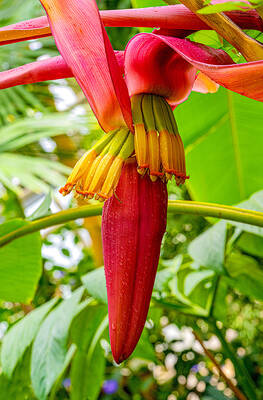After trains began running on the MRT’s Xinyi Line, hordes of people who have heard about where great food can be found make their way out of Dongmen Station and flock to the beautiful streets and alleys for which this neighborhood is known. The best way to enjoy Yongkang Street is to imagine you are strolling along a night market, meandering through this street and that, savoring fabulous cuisine and getting a feel for how this age-old neighborhood has evolved through time.
Yet, if the numerous restaurants, which appeal to both the eyes and the palate, tell the tale of Yongkang Street’s modern life, further exploration reveals stories from its past. As the streets narrow and turn under the glistening twilight, the crowd thins out, the streets become more secluded and cloistered, and you feel as if you were going back in time. Some say this is the real Yongkang Street.
Adjoining Jinan Park are wooden residences made of red walls and black roof tiles, now covered with moss. Qingtian Street’s old buildings, boasting a hybrid of Japanese and Western architecture, have been renovated and turned into art spaces. Whispers from times past murmur in the breeze, telling visitors of what had once been. If you cannot quite catch these whispers, you can pop into the old shops hidden in the corners, where old books, antiques and old furniture are sold, or even a barbershop with its traditional barber’s pole outside. These will offer up their stories.

Photo: Ethan Zhan, Taipei Times
照片:台北時報詹豐造
Yongkang Street is quite unique: on the one hand it embraces the fast pace of change; on the other, it holds onto what has been left behind: the touch of people and their stories. It might be tiring on the legs, but hopefully you will be left with a satisfied soul and a satiated stomach.
Source: Lan Shuan, originally in the Taipei Pictorial, edition 583.
(Translated by Ethan Zhan, Taipei Times)

Photo: Ethan Zhan, Taipei Times
照片:台北時報詹豐造
捷運信義線開通,從東門站吐出一波波慕美食小吃之名而來的紅男綠女,瞬間塞滿素以巷弄之美著稱的社區群落。到永康街區品嘗美食,最推薦的就是來個逛夜市式的走走吃吃,穿梭一條大街、N條巷道,是享受這裡的豐盛美味、感受時空遞嬗氛圍的最佳方式。
然而如果那些目不暇給的餐館食堂是永康街區的今生,接下來的一景一物將帶我們窺見永康街的前世。在金光斜陽下的彎巷窄弄曲折迂迴,人少了、景致清幽了、時光彷彿也老了。有人說,這才是真正的永康街。
錦安公園旁,紅牆黑瓦的木造宿舍爬滿青苔;青田街裡,日洋混搭風格的老屋整修後,以藝文空間重新見客,歷史的微光絮語正隨風窣窣飛旋。若仍聽不清,鑽進藏在街角販售老書、古文物、舊家具的老店,甚至轉動紅藍白招牌的理髮店,它們會悄悄告訴你一些人們的曾經。
永康街區的獨特魅力在於,一部分的她敞開雙臂熱情擁抱快與變,一部分的她則靜靜拾起被匆忙遺落在時光路上的人情溫度和歷史人文的吉光片羽。走了一下午,你的腿或許累了,但希望你的心和胃一樣,是幸福滿足的。
文/蘭萱,《台北畫刊》第583期

Have you ever wondered why “Manila envelopes” carry that name? The answer lies in a plant native to the Philippines. Though a fruit-producing plant, abaca is most valued for its leaf stalks, which are __1__ to extract fibers known as “Manila hemp.” These fibers are known for their strength and resistance to saltwater. Because of its __2__ in sea environments, Manila hemp has long been used to make Manila rope, a staple in the sailing and maritime industries for centuries. It withstands harsh ocean conditions without its flexibility being __3__. Manila rope doesn’t break down easily when exposed to

China commemorated 80 years since the end of World War II last week with a massive military parade against a backdrop of a disputed history about who ultimately defeated Japan. The issues, including Japan’s reckoning with its wartime record in China, are bound to flare again in December, a flashpoint anniversary of the mass killing in Nanjing by invading Japanese troops. Below is an explainer about what the different — and disputed — points of view are. WHAT IS CHINA’S VIEW? For the Chinese government sitting in Beijing, this is a clear-cut issue: China sacrificed 35 million people in a heroic and brutal struggle

In a major step to combat carbon emissions, Norway’s pioneering “Northern Lights project” is set to expand its carbon capture and storage (CCS) capabilities. Backed by energy giants and the Norwegian government, this collaborative project is working to increase its annual carbon storage capacity from 1.5 million to over five million tons. Northern Lights focuses on capturing CO2 emissions from industrial sources across Europe and securely storing them underground. Captured CO2 will be liquefied and transported by ship to the storage facility located off the coast of Norway. It will be injected through pipes into geological formations about 2,600m below the

Rarely does Nature present such a striking contradiction as the one found in Lencois Maranhenses National Park. Located along Brazil’s northeastern coast, the park unveils breathtaking scenery, where rippling sands meet crystal-clear lagoons. Under the sun’s golden glow, the waters glitter in shades of turquoise and emerald. So surreal is this spectacle that visitors might wonder if they’re gazing at a digitally modified photo rather than a living landscape. Were it not for the unique geographical and climatic conditions, such a marvel would not exist. Unlike typical deserts, Lencois Maranhenses receives a substantial amount of rainfall, particularly during the rainy season